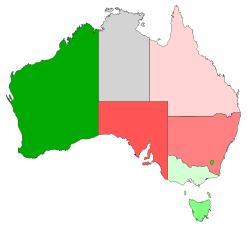| ||||||||||||||||||||||
Are you in favour of the Government having, in this grave emergency, the same compulsory powers over citizens in regard to requiring their military service, for the term of this war, outside the Commonwealth, as it now has in regard to military service within the Commonwealth? | ||||||||||||||||||||||
| Results | ||||||||||||||||||||||
|---|---|---|---|---|---|---|---|---|---|---|---|---|---|---|---|---|---|---|---|---|---|---|
| ||||||||||||||||||||||
 Results by state | ||||||||||||||||||||||
| Note: Saturation of colour denotes strength of vote | ||||||||||||||||||||||

The 1916 Australian referendum, concerning how conscripted soldiers could be deployed, was held on 28 October 1916. It was the first non-binding Australian referendum (often referred to as a plebiscite because it did not involve a constitutional question), and contained one proposition, which was Prime Minister Billy Hughes' proposal to allow conscripted troops to serve overseas during World War I.
Mandatory conscription for males aged 12 to 26 had been implemented in 1911. The use of conscripted troops to fight outside Australia was contentious, although the Australian government had sufficient powers to do so. Due to the controversial nature of the measure, and a lack of clear parliamentary support, Hughes took the issue to a public vote to obtain symbolic, rather than legal, sanction for the move. It was conducted under the Military Service Referendum Act 1916.[1] The referendum sparked a divisive debate that split the nation and resulted in a close but clear rejection of the measure. It directly resulted in the Australian Labor Party split of 1916, the expulsion of Hughes and his supporters from the ALP, and the creation of a new Nationalist Party led by Hughes. After the 1917 election resulted in the re-election of Hughes, a second referendum was held late that year, about the same issue. The government had softened the conscription conditions and simplified the wording of the conscription proposal, but it was also rejected.
- ^ "Military Service Referendum Act 1916". Commonwealth of Australia. 28 September 1916. Archived from the original on 16 January 2017.
